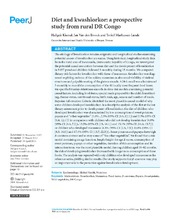| dc.description.abstract | The etiology of kwashiorkor remains enigmatic and longitudinal studies examining potential causes of kwashiorkor are scarce. Using historical, longitudinal study data from the rural area of Bwamanda, Democratic Republic of Congo, we investigated the potential causal association between diet and the development of kwashiorkor in 5 657 preschool children followed 3-monthly during 15 months. We compared dietary risk factors for kwashiorkor with those of marasmus. Kwashiorkor was diagnosed as pitting oedema of the ankles; marasmus as abnormal visibility of skeletal structures and palpable wasting of the gluteus muscle. A 24-h recall was administered 3-monthly to record the consumption of the 41 locally most frequent food items. We specified Hanley–Miettinen smooth-in-time risk models containing potential causal factors, including food items, special meals prepared for the child, breastfeeding, disease status, nutritional status, birth rank, age, season and number of meals. Bayesian Information Criteria identified the most plausible causal model of why some children developed kwashiorkor. In a descriptive analysis of the diet at the last dietary assessment prior to development of kwashiorkor, the diet of children who developed kwashiorkor was characterized by low consumption of sweet potatoes, papaya and “other vegetables” [0.0% , 2.3% (95% CI [0.4, 12.1]) and 2.3% (95% CI [0.4, 12.1])] in comparison with children who did not develop kwashiorkor [6.8% (95% CI [6.4, 7.2]), 15.5% (95% CI [15, 16.1]) and 15.1% (95% CI [14.6, 15.7])] or children who developed marasmus [4.5% (95% CI [2.6, 7.5]) 11.8% (95% CI [8.5, 16.0]) and 17.6% (95% CI [13.7, 22.5])]. Sweet potatoes and papayas have high β-carotene content and so may some of “the other vegetables”. We found that a risk model containing an age function, length/height-for age Z-score, consumption of sweet potatoes, papaya or other vegetables, duration of this consumption and its interaction term, was the most plausible model. Among children aged 10–42 months, the risk of developing kwashiorkor increased with longer non-consumption of these foods. The analysis was repeated with only children who developed marasmus as the reference series, yielding similar results. Our study supports that β-carotene may play an important role in the protection against kwashiorkor development. | en_US |

